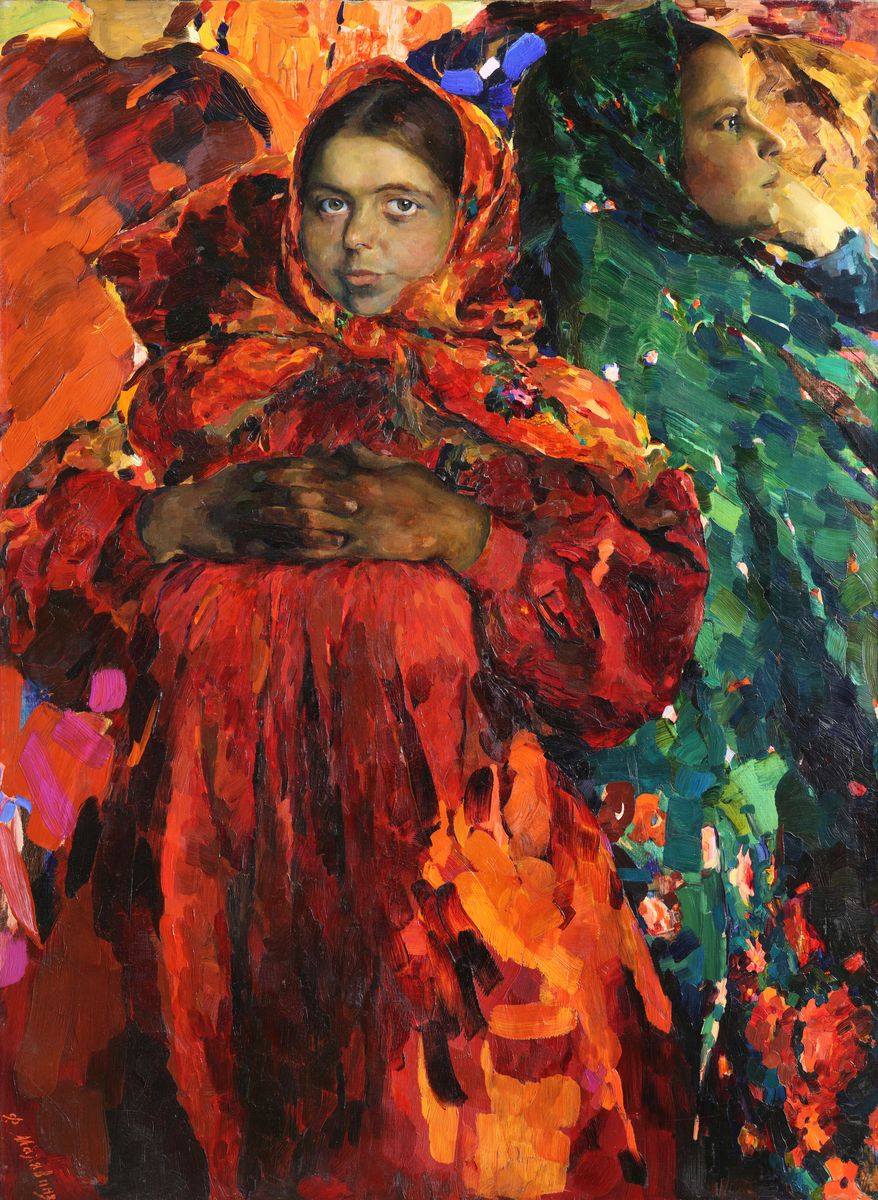


Изображенные на картине задорные и удалые бабы — яркий крестьянский типаж, визуальное воплощение физической мощи, темперамента, народного понимания красоты. Исключительная поглощенность этими образами вытеснила из сферы интересов собственно портретный жанр, с которым связано начало творческого пути живописца.
Моделями большинства полотен художника в то время были крестьянки села Аксиньино под Рязанью, где он построил себе большую мастерскую. Мажорный, яркий, огненный колорит играет решающую роль в создании эмоционального строя картины. По мнению М.А. Врубеля, восхищавшегося широтой письма и самобытностью работ художника, он обладал редким даром "натиска и восторга", вдохновенной напряженностью мироощущения.
_____________________________________
Платки, косынки и шали — важная часть девичьего и женского костюма. Обычай покрывать голову тканью, полотном поверх головного убора появился у славян в древнейшие времена. Появиться на людях с непокрытой головой или хотя бы показать прядь волос было самым большим позором для замужней женщины. Общеславянская архаичная форма головного убора — убрус или головное полотенце, известная с XI века по фрескам и книжным миниатюрам, долго сохранялась в женском костюме. С течением времени на смену домотканым полотенцам пришли мануфактурные изделия.
Фабричные платки и шали бытовали в крестьянской среде в качестве дополнения головного убора или самостоятельного украшения как повседневного, так и праздничного наряда.
В сундуке каждой женщины, независимо от сословия и достатка, всегда хранились несколько платков, предназначенных на все случаи жизни. Эти прекрасные образцы русской текстильной промышленности вошли как неотъемлемая часть в комплекс народной одежды второй половины XIX — начала ХХ века. Красочные наряды крестьянок и купчих, дополненные яркими платками и шалями, запечатлены на полотнах Малявина, Рябушкина, Кустодиева, Нестерова и других художников.
Шали появились в России в конце XVIII — начале ХIХ столетий в аристократической среде как дополнение к изящному ампирному наряду. Изначально их привозили из Европы, позже, в 30-х годах XIX века начали выпускать свои изделия отечественные мануфактуры. Во всех ты, душенька, нарядах хороша. Традиционный праздничный костюм XVIII-XX веков. СПБ, 2015. – С. 190.
Живописец, портретист, рисовальщик.
Академик Императорской Академии художеств (с 1906). Родился в с. Казанка Самарской губернии. Учился в иконописной мастерской при монастыре Св. Пантелеймона на полуострове Айон-Орос в Греции (1885-1891). При содействии скульптора В. А. Беклемишева поступил в Академию художеств, где учился у И.Е. Репина (1892-1899). Член "Союза русских художников" (с 1903). Его работы отмечены золотой медалью Всемирной выставки в Париже (1900). Преподавал в рязанских Государственных свободных мастерских. С 1922 жил за границей. Писал в основном портреты и жанровые сцены из крестьянской жизни. Создал свой собственный, лаконичный стиль портретного рисунка.

A student of the Imperial Academy of Arts at the end of the nineteenth century, Philipp Malyavin introduced a new type of peasant woman into Russian art ‒ a stately, proud and sometimes intrepidly independent woman. His models were the inhabitants of the villages of Ryazan Province, dressed in bright festive attire. The painting is a sublime and romantic image of Russian womenfolk, with their wholesome characters and inner stature. The faces of the girls are meaningful, the looks in their eyes are intent and enigmatic, the colours of their attire glimmer in a bewitching manner. The expressive images are intensified by the artist’s inspired and temperamental painting.
Kerchiefs, headscarves and shawls are an important part of costume for girls and women. The Slavs adopted the tradition of covering the head with cloth or linen in ancient times. “Exposing the hair”, that is letting the ends of the hair show (that is to say nothing of appearing in public with an uncovered head), was the most shameful thing a married woman could do. The usual Slavic headdress of a towel or head scarf, recognizable in frescoes and miniature paintings in books from the 11th century, have long remained a part of female costume. Over time, homespun headscarves were replaced by manufactured textiles. Mill-finished headscarves and shawls were used in peasant circles as a complement to headdress or individual decorations such as every day or festive attire.
Every woman, regardless of her class or income, kept several headscarves in her trunk for any life event. In the latter half of the 19th century and early 20th century, these beautiful examples of the Russian textile trade became an integral part of folk costume. Colorful peasant and merchant garments, embellished with bright headscarves and shawls, were painted on the canvases of Malyavin, Ryabushkin, Kustodiev, Nesterov and other artists.
Painter, draughtsman, portraitist, genre artist. Studied at the Holy Monastery of Agios Panteleimon on Mount Athos in Greece (1885-92) and under Pavel Chistyakov and Ilya Repin at the Higher School of Art, Imperial Academy of Arts (1892-99). Academician of painting (1906). Contributed to exhibitions (from 1895). Contributed to the exhibitions of the World of Art (1899-1903, 1906, 1921-22), Berlin Sezession (1903, 1904), Union of Russian Artists (1903-23), Exposition Universelle in Paris (1900), Venice Biennales (1901, 1907, 1924), L''Exposition de 1''Art Russe in Paris (1906) and Berlin (1906) and the Salon d''Automne in Paris (1923, 1924). Emigrated (1922).



